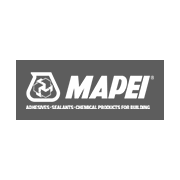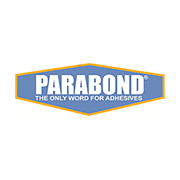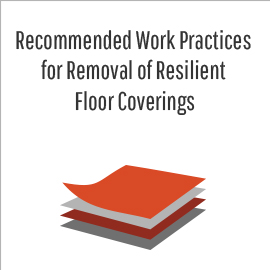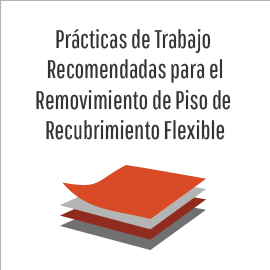Technical information at your fingertips
There’s a lot of important technical information that you need to know about resilient flooring products. It affects everything from installation to safe removal of your flooring So, at RFCI, we’re bringing all these technical guidelines together in one place to make it easier for you to access the facts you need, whenever you need them.
The truth about indentation and resilient flooring
Static Load limit testing determines how well flooring withstands and recovers from indentation by heavy objects like household furniture or commercial equipment. A overview can be found in the static load limits section.
Installation explained means installation done right
Beautiful resilient flooring is the result of proper installation. RFCI member companies have developed detailed instructions for installing each of their flooring products to ensure customers will be satisfied with the finished installation. These installation instruction should be followed closely. To obtain installation installations go to the “Members” section to connect to the flooring company from which a product has been purchased. Member websites will also provide information on the correct procedures which should be followed to properly maintain a flooring product.
Proper removal of resilient flooring
If you’re remodeling or otherwise need to take up your current flooring, you’ll want to read over this comprehensive guide on the recommended practices for the removal of resilient flooring. Have tile flooring? Sheet flooring? Stubborn adhesives? Wood underlayment? We’ve got the step-by-step instructions you need to remove your flooring properly.
Answers to everyday concerns about waterproof flooring
Resilient flooring – a category of flooring products including luxury vinyl tile, linoleum, rubber and more – has a well-deserved reputation for its impervious surface that is affected very little from surface spills, heavy wet-mopping, and more.
Using recycled and recyclable materials
Cutting back on waste generation
Reducing packaging-or eliminating it altogether
Lowering product emissions
Documents
Moisture Control and Resilient Flooring Installation
Recommended Work Practices for Removal of Resilient Floor Coverings
Flooring Surfaces: Americans with Disabilities Act (ADA) Accessibility Guidelines
Waterproof Resilient Flooring
Independent White Paper: Bacterial Growth on Vinyl and Polished Concrete
VIDEO: Analysis of Bacterial Growth on Vinyl and Polished Concrete Flooring
-
Installation
-
ASTM & ISO Standards
-
Floor Maintenance
-
Floor Removal
-
Static Load Limits
-
Independent Technical Consultants
Installation simplified.
Resilient flooring is such a popular choice, because it offers so many unique benefits, from major cost savings and exceptional versatility to true sustainability. If you haven’t looked into resilient flooring recently, you’ll also discover a world of new developments and designs that are making it an even more attractive choice. You can find out more about topics such as installation, maintenance, standards, and specifications by browsing our Knowledge Center right now.
- Make sure all sub-flooring is properly prepped. All underfloors must be clean, with all traces of dust, dirt, wax, and other foreign substances fully removed. Underfloors should also be smooth – this means securing and setting any fasteners flush with the sub-floor and filling in any cracks or seams.
- Have the right tools and materials on hand. Use the manufacturer’s recommended materials, tools, and adhesives. These recommendations really do make a difference. They help ensure that your flooring is properly installed and under warranty.
- Carefully plan your layout before you start work. Rooms must be accurately measured, and the layout of the flooring should be adequately planned in advance. Also, remember that it’s common practice to order 2-3% extra flooring materials to accommodate any last-minute planning changes or future repairs.
- Recommended work practices for the removal of resilient floor coverings. Older resilient floors may contain asbestos so be sure to check out the proper and approved procedures for flooring removal.
Always put safety first
During installation and curing, rooms should be well ventilated to minimize VOCs and ensure that proper indoor air quality is maintained. Use fans and open any doors or windows to increase fresh air flow.
Some installation materials may also be highly flammable. We recommend that open flames and other potential sources of ignition be avoided during the installation process.
Environmental Protection Agency (EPA)
Lead: Renovation, Repair, and Painting Program
This EPA link provides information related to the April, 2000 EPA ruling requiring the use lead-safe practices and other actions aimed at preventing lead poisoning. Under the rule, beginning April 22, 2010, contractors performing renovation, repair and painting projects that disturb lead-based paint in homes, child care facilities, and schools built before 1978 must be certified and must follow specific work practices to prevent lead contamination.
Get the full details
We’ve already highlighted some key points that will make your installation a success. But we also recommend that you check out the links below :
If you are a retailer or flooring contractor and your installers need the required training regarding the removal of flooring that may contain asbestos, follow this link to a network of RFCI licensed trainers.
Or, follow this link to visit our member websites for product-specific installation guidelines.
Or, need technical assistance regarding adhesives? Follow these links to RFCI Associate member sites:
International Organization for Standardization (ISO)
ASTM International is one of the largest voluntary standards development organizations in the world-a trusted source for technical standards for materials, products, systems, and services. Known for their high technical quality and market relevancy, ASTM International standards have an important role in the information infrastructure that guides design, manufacturing and trade in the global economy.
ASTM International, originally known as the American Society for Testing and Materials (ASTM), was formed over a century ago, when a forward-thinking group of engineers and scientists got together to address frequent rail breaks in the burgeoning railroad industry. Their work led to standardization on the steel used in rail construction, ultimately improving railroad safety for the public. As the century progressed and new industrial, governmental and environmental developments created new standardization requirements, ASTM answered the call with consensus standards that have made products and services safer, better and more cost-effective. The proud tradition and forward vision that started in 1898 is still the hallmark of ASTM International.
ISO (International Organization for Standardization) is the world’s largest developer and publisher of International Standards. Standards ensure desirable characteristics of products and services such as quality, environmental friendliness, safety, reliability, efficiency and interchangeability – and at an economical cost. When products do not perform well it often is because they have not met the requirements of a standard.
Members of the Resilient Floor Covering Institute (RFCI) have been participating in the development of ISO Standards for resilient floor covering since 2001. The purpose of these ISO resilient flooring standards is to establish standards which are accepted worldwide. There are several types of standards. The standards which ISO Technical Committee #219 (Carpet, Resilient & Laminate flooring) has been developing are primarily test method standards and product specification standards.
ISO standards provide the assurance that U.S., Canadian and Mexican resilient flooring products will be accepted worldwide if they meet the requirements in the ISO standards. Conversely specifiers in North America are assured that flooring products produced outside North America meet the same requirements as North American resilient flooring products.
Technical Committee #219, Working Group 2 (Resilient Flooring) has developed the standards shown below. Additional standards are in the process of being developed. These standards are available for purchase and can be accessed by clicking the ISO links below.
Committee F06 on Resilient Floor Coverings
 ASTM Committee F06 on Resilient Floor Coverings was formed in 1968. F06 meets twice a year, usually in May and November, with approximately 50 members attending two and one half days of technical meetings capped by a discussion on relevant topics in the Resilient Flooring industry. The Committee, with a membership of about 150, has jurisdiction of over 42 standards, published in the Annual Book of ASTM Standards, Volume 15.04. F06 has 6 technical subcommittees that maintain jurisdiction over these standards. Information on this subcommittee structure and F06’s portfolio of approved standards and Work Items under construction are available from the Lists of Subcommittees, Standards and Work Items at the ASTM link below. The various standards are listed along with the associated cost for obtaining the documents. These standards have and continue to play a preeminent role in all aspects important to the industry of resilient floor coverings and related products, including linoleum, vinyl, vinyl composition, asphalt, rubber, cork, and the like, in which the wearing surface is non-textile.
ASTM Committee F06 on Resilient Floor Coverings was formed in 1968. F06 meets twice a year, usually in May and November, with approximately 50 members attending two and one half days of technical meetings capped by a discussion on relevant topics in the Resilient Flooring industry. The Committee, with a membership of about 150, has jurisdiction of over 42 standards, published in the Annual Book of ASTM Standards, Volume 15.04. F06 has 6 technical subcommittees that maintain jurisdiction over these standards. Information on this subcommittee structure and F06’s portfolio of approved standards and Work Items under construction are available from the Lists of Subcommittees, Standards and Work Items at the ASTM link below. The various standards are listed along with the associated cost for obtaining the documents. These standards have and continue to play a preeminent role in all aspects important to the industry of resilient floor coverings and related products, including linoleum, vinyl, vinyl composition, asphalt, rubber, cork, and the like, in which the wearing surface is non-textile.
Resilient Flooring: Easy to maintain its beauty
One of the most popular features of resilient flooring is that it’s so easy to clean. Resilient flooring is moisture resistant and doesn’t trap dirt and dust the way other surfaces do. It’s also naturally stain resistant. Spills just wipe away. That’s the good news.
But, since we haven’t developed a self-cleaning product just yet, we’ve got some general maintenance tips to help keep your flooring spic-and-span. By following these few, simple tips, you can extend the life of the flooring, help protect the environment, and keep your premises looking great.
Four routine maintenance steps that help your flooring look its best
- Wipe up any spills with a damp cloth or mop as soon as possible
- Vacuum, sweep, or dust on a regular basis to remove dirt and debris that could scratch or scuff the flooring
- Damp mop and spot clean the flooring as needed for a deeper clean
- Review product manufacturer’s maintenance recommendations since maintenance requirements vary depending on product type.
Four must-know preventative maintenance tips
- Place protective rubber castors or felt glides under furniture to prevent scratching or other damage
- Use mats at main entrances to trap dirt and prevent tracking
- Make sure all rugs and mats have a safe, slip-resistant backing
- Choose rugs and mats made with breathable materials to prevent flooring discoloration
Static Load Limit Testing of Resilient Flooring Products
Some resilient flooring manufacturers are claiming extremely high (PSI) static load limit ratings for their flooring products. This has led to confusion in the market place where architects, specifiers, designers and end users are led to believe that they are better protected against indentation and damage to the flooring products they have chosen than they are in reality. The purpose of this document is to explain static load limit testing and ensure that the end users, expectations of indentation resistance and recovery from indentation are realistic.
Static load testing, as it relates to resilient flooring generally refers to ASTM Test Method F-970, titled Standard Test Method for Static Load Limit. This test method is designed to evaluate the ability of a flooring product to withstand or recover from indentation. In the test method, a load for example, 175 pounds per square inch (PSI), is applied to the flooring for 24 hours. The load is then removed, and the material is allowed to recover f or another 2 4 hours after which the amount of residual indentation is measured. The pass/fail criterion is a residual indentation of no greater than 5 mils.
Following are important considerations you should know regarding static load limit testing :
- Static load testing is currently performed on an uninstalled product. The same test conditions utilized on an installed product can give very different results, generally worse and sometimes much worse.
- ASTM product specifications, which largely govern the consensus specifications to which most U.S. resilient flooring manufacturers claim to conform, do not cite a static load requirement higher than 250 PSI for any product specification covering the category of resilient flooring.
- Few objects within a residential household exceed a 125 PSI loading on the surface of a floor and commercially few objects exceed 750 PSI.
- Since static load testing is generally performed for longer time periods (24 hours or more), other test methods have been developed to measure short-term indentation resistance. These tests are utilized to evaluate a product’s hardness or ability to resist indentation caused by short-term loads such as stiletto heels. Even these tests are typically performed on the product in an uninstalled condition.
- Static load testing differs from dynamic load testing. Static load testing gently places a load on the floor for a specified time, gently removes the load at the end of the test, then after another given time the location where the load was placed is measured for residual indentation. Dynamic loads are created when a load is placed on the floor, and then moved around the floor’s surface by a rolling, sliding or dragging motion.
Below are some examples of static and dynamic loads :
- Desks, tables and filing cabinets are common examples of static loads. A desk weighing 400 lbs, with four feet, each having approximately one square inch of contact with the floor would generate a load of l00 PSI at each foot on the floor’s surface.
- An occupied hospital bed weighing approximately 700 pounds, with four wheels each having 0.3 square inches of contact area would produce a floor loading of 583 PSI per wheel. Moving or sliding the bed while the wheel brake is engaged introduces a dynamic component and therefore would not be considered a normal static load situation. In recent years, flooring damage caused by hospital beds has become more common. A bed 1ike the one described in this example, in a genuine static load situation, may produce at most a slight but noticeable indentation in the installed flooring. It is the introduction of the dynamic component (sliding/moving) in combination with the high loads exerted by the wheels that can produce far more damaging results. Rips, tears, gouges, displacement of adhesive and delamination of the flooring can result from this combination of forces. A static load rating on an uninstalled flooring sample does not reflect the product’s ability to withstand the unique forces generated in these types of dynamic situations without damage to the integrity of the flooring. In this case of dynamic loading, most resilient flooring manufacturers recommend that resilient flooring should be installed directly on the concrete using a reactive hard set adhesive where heavy moving loads are anticipated. Hospital bed manufacturers should provide equipment with anticipated PSI loading, preferably below 250 PSI, and on the extreme side, below 750 PSI in addition to notifying end users that special precautions should be taken in the selection of the flooring system and installation technique-
- Stiletto heels, although representing a potentially high PSI loading, are not considered a static load condition. The amount of time the load is in contact with the surface of the floor is generally short and more dynamic in nature.
Based on the examples above, three objectives become apparent :
- It needs to be clearly communicated that the current static load limit values reflect the capabilities of the product from a quality control standpoint and may not reflect the installed performance.
- The static load test method needs to be revised or a new test method developed to better reflect the static load limit performance of an installed floor.
- A new or modified test method needs to be developed to provide information on product durability under heavy dynamic loads.
Static load limit is one characteristic of a floor’s durability; others include i.e., stain resistance, puncture resistance, and ease of maintenance. No flooring product is indestructible. Misleading product claims that do not reflect a floor’s performance relative to the intended use does the entire flooring industry a disservice by potentially leaving a customer dissatisfied because of unfulfilled or mismatched expectations.
There is work under development within ASTM to address the issue of potential damage that can be caused by shifting heavy loads on the surface of a floor. Ideally ASTM will be successful in developing a static load test method utilizing an installed assembly and/or the development of a dynamic load test to evaluate the ability of the floor to withstand movement under a load. Until new testing methodology is developed, the best advice is to judge the technical information and merit of a flooring product upon what is ultimately covered or not covered by a floor product warranty.
Independent Technical Consultants
To resolve any problem or question related to your flooring installation, the best first course of action is to work through your flooring retailer or contractor. Or, if you are a retailer or flooring contractor you may encounter situations where you need help. Should a situation arise where you need specialized services, there are a wide range of independent technical consultants available. RFCI is providing several contacts based on the recommendations of our member companies. However, neither RFCI or our member companies warrant or in any way guarantee any services that you may contract for.
LGM and Associates
Area of Focus:
- guidance and consulting on all flooring materials, substrates, concrete and moisture issues
- complaint, claims assistance, and onsite physical inspection
- mediation and dispute resolution
- identifying concrete, moisture and flooring failures
- legal case assistance and proffered expert witness
- specifications, consulting and information – before and after the sale
- oversee manufacturing and inspection of product at the source
- educational seminars
- certified product testing
- installation oversight, guidance correction and specification writing
- insurance loss evaluations
National Institute of Certified Floor Covering Inspectors
Flooring Contractors Association
Independent Floor Testing and Inspection
Area of Focus:
- IFTI provides national independent third-party testing and certification of moisture-related issues, from pre-floor covering concrete slab moisture testing to post-floor covering root cause failure analysis and recommendations for cost-effective solutions.
Install Floors
Area of Focus:
- Installation training- apprenticeship through career-long continuing education
- Industry directed, recommended, endorsed, and specified installation certifications
- Source of the only free, extended, non-proprietary, third-party, floor covering installation warranty in North America
- Unique source of employed, professional, floor covering installation teams responsible for complete floor covering purchase and installation
- Specification consultation expert in product selection and installation standards











